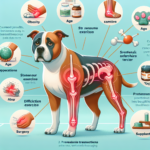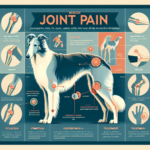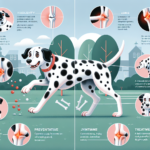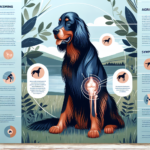American Eskimo Dog Joint Pain: Causes, Symptoms, Prevention, and Treatment

Introduction
The American Eskimo Dog, often affectionately called the “Eskie,” is a breed known for its striking white coat, keen intelligence, and friendly demeanor. Originating from the Spitz family, this breed has a rich history that includes roles as circus performers and loyal companions. Eskies come in three sizes: toy, miniature, and standard, making them versatile pets for various living situations. Despite their robust appearance and energetic nature, American Eskimo Dogs are prone to certain health issues, with joint pain being a significant concern.
Joint health is crucial for the American Eskimo Dog due to their active lifestyle and genetic predispositions. Ensuring that their joints remain healthy can significantly enhance their quality of life and longevity. This article delves into the causes, symptoms, prevention, and treatment of joint pain in American Eskimo Dogs, providing a comprehensive guide for owners to keep their pets healthy and happy.
Breed-Specific Joint Pain Risks
Genetic Predisposition
American Eskimo Dogs are genetically predisposed to several joint-related issues, including hip dysplasia, arthritis, and elbow dysplasia. Hip dysplasia is a condition where the hip joint doesn’t fit into the hip socket properly, leading to pain and mobility issues. Arthritis, a common ailment in older dogs, involves the inflammation of joints, causing pain and stiffness. Elbow dysplasia, though less common, can also affect this breed, leading to similar symptoms in the front limbs.
Age-Related Risks
As American Eskimo Dogs age, the risk of developing joint pain increases. Typically, signs of joint issues may start appearing as early as five to seven years of age. However, this can vary depending on the individual dog’s genetics, lifestyle, and overall health. It’s essential for owners to be vigilant about their dog’s joint health as they approach these age milestones.
Activity Level and Joint Stress
American Eskimo Dogs are known for their high energy levels and love for physical activities. Whether it’s running, jumping, or playing fetch, these activities can put significant stress on their joints. While exercise is crucial for their overall health, excessive or high-impact activities can exacerbate joint issues. Owners should strike a balance between keeping their Eskie active and not overburdening their joints.
Common Symptoms of Joint Pain in American Eskimo Dogs
General Symptoms
- Limping: One of the most noticeable signs of joint pain is limping or favoring one leg over the other.
- Stiffness: Dogs may show stiffness, especially after resting or sleeping.
- Reluctance to Move: A dog in pain may be hesitant to climb stairs, jump onto furniture, or go for walks.
- Decreased Activity: A reduction in playfulness or overall activity levels can indicate joint discomfort.
- Behavioral Changes: Irritability, aggression, or withdrawal can be signs of chronic pain.
Breed-Specific Symptoms
In American Eskimo Dogs, joint pain may manifest as a reluctance to perform activities they once enjoyed, such as agility exercises or playing fetch. Owners might also notice a change in their gait or an unusual posture when sitting or lying down.
When to Consult a Vet
If you observe any of the above symptoms in your American Eskimo Dog, it’s crucial to consult a veterinarian promptly. Early diagnosis and intervention can prevent the progression of joint issues and improve your dog’s quality of life. Regular veterinary check-ups are also essential for monitoring joint health, especially as your dog ages.
Preventive Measures for Joint Health
Exercise Recommendations
Regular, moderate exercise is vital for maintaining joint health in American Eskimo Dogs. Activities like walking, swimming, and low-impact play are excellent choices. Avoid high-impact exercises like excessive jumping or running on hard surfaces, which can strain the joints. Tailor the exercise routine to your dog’s age, size, and energy level to ensure they stay active without overexerting their joints.
Dietary Suggestions
A balanced diet rich in essential nutrients can support joint health. Consider incorporating foods or supplements that contain glucosamine, chondroitin, and omega-3 fatty acids, which are known to promote joint health and reduce inflammation. Consult your veterinarian for specific dietary recommendations tailored to your dog’s needs.
Weight Management
Maintaining a healthy weight is crucial for reducing joint stress. Excess weight can exacerbate joint issues and lead to more severe pain and mobility problems. Monitor your dog’s weight regularly and adjust their diet and exercise routine as needed to keep them at an optimal weight.
Early Screening and Monitoring
Regular veterinary check-ups and early screening for joint issues can help catch problems before they become severe. Your vet may recommend specific tests or imaging studies to assess joint health, especially if your dog is genetically predisposed to joint conditions. Early intervention can significantly improve outcomes and quality of life.
Treatment Options for Joint Pain
Non-Surgical Treatments
Non-surgical treatments for joint pain in American Eskimo Dogs include medications, physical therapy, and lifestyle adjustments. Anti-inflammatory drugs and pain relievers can help manage symptoms, while physical therapy can improve mobility and strengthen muscles around the joints. Lifestyle adjustments, such as providing a comfortable bed and avoiding high-impact activities, can also alleviate pain.
Surgical Options
In severe cases, surgical intervention may be necessary. Common surgical options include hip replacement, arthroscopy, and joint fusion. These procedures can provide significant relief and improve mobility, but they come with risks and require a thorough discussion with your veterinarian to determine the best course of action for your dog.
Alternative Therapies
Alternative treatments like acupuncture, hydrotherapy, and massage can also benefit American Eskimo Dogs with joint pain. Acupuncture can help reduce pain and inflammation, while hydrotherapy provides low-impact exercise that strengthens muscles without stressing the joints. Massage therapy can improve circulation and alleviate muscle tension, contributing to overall joint health.
Lifestyle and Management Tips
Daily Care Routine
A consistent daily care routine can help manage and alleviate joint pain in American Eskimo Dogs. This routine might include gentle exercise, a balanced diet, and regular administration of any prescribed medications or supplements. Monitoring your dog’s behavior and adjusting their routine as needed can also help manage pain effectively.
Modifying the Home Environment
Making your home more comfortable for a dog with joint pain can significantly improve their quality of life. Consider using ramps instead of stairs, providing orthopedic beds, and ensuring that food and water bowls are at a comfortable height. These modifications can reduce strain on your dog’s joints and make daily activities easier.
Long-Term Management
Long-term management of joint pain involves regular veterinary check-ups, ongoing monitoring of your dog’s condition, and adjustments to their care routine as needed. Keeping your dog active and engaged with low-impact activities can help maintain their mobility and overall well-being. Consistent weight management and a balanced diet are also crucial for long-term joint health.
FAQs About American Eskimo Dogs and Joint Pain
What are the early signs of joint pain in American Eskimo Dogs?
Early signs of joint pain include limping, stiffness, reluctance to move, decreased activity levels, and behavioral changes such as irritability or withdrawal.
Can joint pain in American Eskimo Dogs be prevented?
While genetic predispositions cannot be entirely prevented, maintaining a healthy weight, providing a balanced diet, and ensuring regular, moderate exercise can significantly reduce the risk of joint pain.
Are there specific foods that can help with joint health?
Yes, foods rich in glucosamine, chondroitin, and omega-3 fatty acids can support joint health. Consult your veterinarian for specific dietary recommendations tailored to your dog’s needs.
When should I consult a vet about my dog’s joint pain?
If you notice any signs of joint pain, such as limping, stiffness, or reluctance to move, consult your veterinarian promptly. Early diagnosis and intervention can prevent the progression of joint issues.
What are the best exercises for an American Eskimo Dog with joint pain?
Low-impact exercises like walking and swimming are excellent choices. Avoid high-impact activities that can strain the joints, and tailor the exercise routine to your dog’s age, size, and energy level.
Conclusion
Joint pain is a significant concern for American Eskimo Dogs, but with proper care and attention, it can be managed effectively. By understanding the causes, symptoms, prevention, and treatment options, owners can take proactive steps to ensure their dog’s joint health. Regular veterinary check-ups, a balanced diet, appropriate exercise, and a comfortable home environment are crucial for maintaining your Eskie’s quality of life. Remember, early intervention and consistent care are key to keeping your American Eskimo Dog happy and active for years to come.




